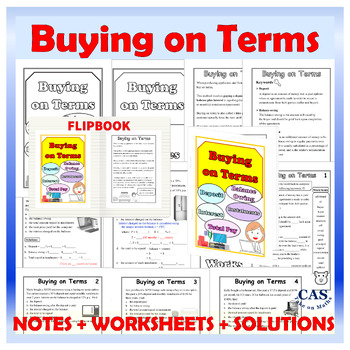Consumer Math | Shopping with Buying on Terms
- Zip
- Easel Activity
Also included in
- Consumer Math Bundle.3 Resources included in this bundle.Consumer Math | Shopping | Cash or Lay-buyConsumer Math | Shopping | Discount on Discounted PriceConsumer Math | Shopping | Buying on TermsLearning Outcomes:Solve financial problems involving purchasing goods (with cash or a lay-by plan)CalculPrice $14.58Original Price $16.20Save $1.62
Description
Consumer Math flipbooks help students to
- understand the concept of buying on terms.
- calculate the cost of buying items by paying a deposit and making regular repayments that include simple interest
The flipbook comes in 2 styles.
- Style 1: Cover, fill in the blank notes and worksheets
- Style 2: Cover, completed notes and worksheets
Total pages in each flipbook: 11
Easy classroom preparation: Just print and glue each page in students’ notebooks or staple all pages together to make a flipbook.
Answer keys and students' folded notes are also included.
Fill in the blank scaffolded notes and worksheet 1 are also available in the Easel activity by TPT.
The teacher and students complete the activity using an easel pen or typing.
Level of Difficulty: Beginner (Easy)
Grades: 9th to 12th
Key learning: Students
- Solve financial problems involving purchasing goods and simple interest.
- Understand buying on terms.
- Calculate buying on terms deposit.
- Finding the interest charged in dollars or as a percentage of the balance owing.
- Calculate the total cost using buying on terms.
- Calculate the extra pay using the buying on terms method.
- Calculate each regular instalment.
Australian Curriculum:
- Solve financial problems involving purchasing goods (MA4-6NA)
- Solve problems involving simple interest (ACMNA211)
- Apply appropriate mathematical techniques to solve problems (MA4-2WM)
- Calculate a percentage of a given amount (ACMEM011)
- Determine one amount expressed as a percentage of another (ACMEM012)
Consumer Math Resources:
Discount Scaffolded Note and Formulas
Discount Flipbook: Notes + Examples, Worksheets + Answers (Beginner)
Discount Worksheets + Answers (Advanced)
Successive Discounts Pair Task 1
Successive Discounts Pair Task 2







